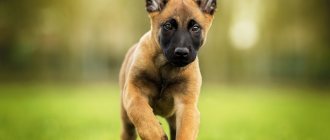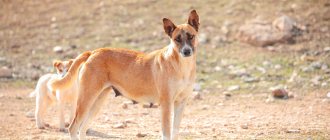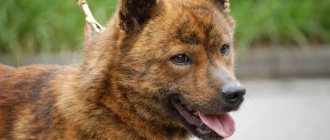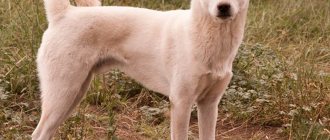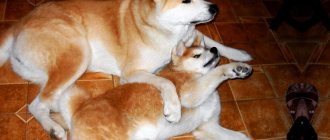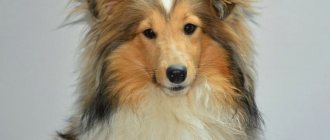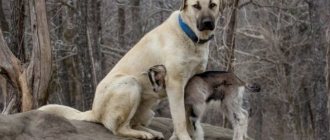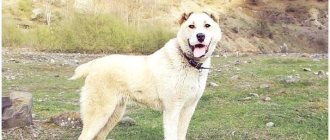History of the Belgian Shepherd breed
Belgian Shepherd
It would seem that the history of this shepherd dog should be rooted in antiquity. And indeed: even in written sources of the 17th century there are references to four-legged assistants to shepherds who looked after numerous flocks. Thus, the first description of Belgian Shepherds (or at least dogs very similar to them) dates back to 1650. However, in fact, the breed is relatively young and has existed for just over a hundred years. How is this possible?
This is all explained by the fact that in ancient times there were no people who would purposefully breed shepherd dogs. Moreover, the breed was not considered prestigious. Representatives of the European aristocracy did not bother creating kennel clubs, while their faithful preferred to keep representatives of other breeds as pets. The lion's share of shepherd breeding was done by peasants, who attached great importance to the working qualities of the dogs, and not to their attractive exterior.
By the second half of the 19th century, shepherd dogs were already distinguished by a huge palette of colors, but were still valued only for their purpose - the ability to herd a flock,, if necessary, gather sheep together and protect them from attacks by wild animals. The attitude of Belgian farmers towards these incredibly smart dogs was no exception. Everything changed with the beginning of the industrial revolution.
That moment was a turning point: Belgium's economy was being reinvented, and the accelerated pace of urbanization was forcing rural residents to move to larger cities. This had a negative impact on the popularity of herding dog breeds, which lost their importance.
Muzzle of a Belgian Shepherd Tervuren puppy
The Belgian Shepherd owes its appearance to the wave of nationalism that swept Europe in the 19th century. At that time, many countries sought to create a breed of dog that would become their national treasure and be radically different from others. The end of September 1891 was marked by the creation in Brussels of the cynological organization BSDC - the Belgian Shepherd Lovers Club. In November of the same year, the first dog exhibition was held in the city of Kurgam, where more than a hundred animals were presented. Among the guests of the event was Professor Adolf Riyul, who studied dogs and in the future planned to introduce a specific breed for each region of Belgium.
Only a third of the shepherd dogs present at the exhibition were recommended by scientists for further breeding. Riyul selected medium-sized animals, without paying attention to the length and structure of the wool - only its quality mattered. In 1892, the professor introduced the world to the first standard of the Belgian Shepherd breed. The selection of dogs lasted about two decades. Initially, cynologists identified three varieties of the breed depending on color. This prompted dog breeders, whose wards did not correspond to any of the three categories, to create a separate canine circle and continue independent breeding of animals. The confrontation lasted for several years until the clubs merged and, as a consequence, the breed standard changed. To this day, it provides for four categories of dogs:
1. Groenendael – black in color with medium-length fur. They owe their name to a small village near Brussels.
2. Laekenois – ash-gray color with long hair. The breed variety is named after the historical district of Laeken in the north of the capital.
3. Malinois - charcoal or brown-yellow in color with short hair. They inherited the name from the town of Malina (Mechelen).
4. Tervuren – charcoal-red color with long hair. The name of this breed category comes from the city of Tervuren, 8 km from the capital.
Belgian Shepherd Groenendael
Belgian Shepherd Tervuren
Belgian Malinois
Belgian Shepherd Laekenois
Belgian Shepherd Groenendael puppy
Controversy regarding Belgian Shepherds continues to this day. Some breeders believe that these are different breeds of dogs, the Federation of Cynologists - that they are one and the same. In general, it is customary to adhere to the second point of view.
The next stage on the path to the formation of the breed was the appeal of the breeders to one of the largest cynological organizations of that time - the Royal Society of St. Hubert (RSSH). The application for breed recognition was rejected. It was only after the final modernization of standards in 1901 that the Belgian Shepherd was officially recognized and registered by members of the RSSH. For each of the four varieties, standards were formulated that primarily fixed the color and length of the coat.
Since the beginning of the 20th century, representatives of the breed were among the first to serve in the Belgian police. At the same time, shepherd dogs were used to patrol the borders of the state and catch smugglers. In 1907, Groenendaels appeared in the United States. A year later, representatives of the breed were already actively patrolling the streets of France.
During the First World War, Belgian Shepherds played an equally important role. Animals carried out responsible guard duty, served as military postmen, and helped pick up the wounded from the battlefield. It was at that time that people took a different look at the breed and saw important traits in it: courage, loyalty and strength. Gradually, Belgian Shepherds earned the love of the whole world. However, it is worth noting that the popularity of the breed is uneven. The most preferred are the Groenendael and Malinois.
Temperament
A calm, reliable, patient, manageable and attentive dog with a pronounced, extreme independence and focus characteristic of Molossers. Possesses exceptional strength and fearlessness. Tosa is very loyal to its owner, distrustful of strangers and aggressive towards its relatives. Training this serious fighting dog requires firmness and perseverance from the owner. Historically, this breed did not promote or develop hatred and anger towards humans; on neutral territory, it is absolutely loyal to him, unless we are talking about a physical threat to the owner, his child or his own puppies.
Tosa on a postage stamp of Tajikistan
Tosa is genetically endowed with the ability to make an independent assessment of the situation, so even if the owner does not have time to give the appropriate command, the dog will act decisively. Even without special training, Tosa is a good bodyguard. In the family, this brave dog is affectionate and gentle, and according to American researchers, in Japan purebred Tosa Inu were used as nannies. The Japanese Kennel Club classifies the Tosa as a companion dog, emphasizing its intelligence and high controllability.
Appearance of the Belgian Shepherd
Belgian Malinois
The Belgian Shepherd is a large breed of dog. These animals look elegant and well-coordinated, despite their rather large dimensions. Thus, the height of males at the withers reaches 61-66 cm, while females usually grow to 56-61 cm.
The weight of Belgian Shepherds varies between 20-30 kg. Minor deviations from this standard are acceptable.
Head and skull
The dog's head is folded harmoniously, but at the same time it looks rather dry. Moderately lengthened, set high. The skull is proportional to the head in all respects. The animal's forehead is flattened and does not have a clearly defined midline. When the Belgian Shepherd's head is turned in profile, it becomes noticeable that the lines of the muzzle and forehead are parallel to each other. The cheekbones are poorly defined, but at the same time they are distinguished by well-developed muscles. The same applies to the brow ridges of the animal.
Muzzle
The shepherd's muzzle is not much longer than the skull and gradually tapers towards the end. Stop moderate. The nostrils are wide open, the nose has rich black pigmentation. Thin lips are pressed tightly to the jaws, the mucous membrane is characterized by the absence of pink areas.
Ears
Belgian Shepherd Tervuren
Set high, they have an almost perfect triangular shape. Their tips are pointed, while the ears are smoothly rounded at the base. When the Belgian Shepherd is alarmed by something, its ears stand upright and straight.
Eyes
They are medium in size and almond-shaped. The pigmentation of the iris is brown, and the richer it is, the better. The eyelids are “rimmed” with black. Belgian Shepherds have a lively and inquisitive look, from which not a single important detail escapes.
Jaws and teeth
White teeth are densely recessed in well-developed jaws. The standard provides for scissor and level bites (the latter being less preferred, but increasingly being chosen by shepherds). The dental formula is complete. The absence of first premolars is not considered a defect.
Neck
The straight and rather elongated neck of the Belgian Shepherd is set high and is characterized by the absence of dewlap. It widens towards the shoulder blades and has a smoothly curved scruff.
Muzzle of a Malinois shepherd dog
Frame
The massive body of the animal does not look heavy and is distinguished by the observance of certain proportions. So, in males, the length of the body corresponds to the height; in bitches the first parameter may be slightly larger. The chest is moderately wide, but at the same time it is voluminous, like all dogs, which are characterized by excellent endurance. The ribs are smoothly curved. The pronounced withers merge into a straight topline. The abdomen is relatively tucked, the croup is located at a slight slope. The muscles are sculpted.
Tail
Belgian Shepherd Groenendael
Medium length, has a wide base. In a calm state, the animal keeps its tail lowered, only the tip is slightly curved upward at the level of the hocks. In movement, the tail rises, without bending or taking the shape of a hook.
Forelegs
The shepherd's strong limbs have strong bones and well-developed muscles. The long shoulder blades and shoulders form a fairly wide angle for elbow movement. The forearms are surrounded by strong muscles. Short pasterns lead into rounded paws with curved and tightly clenched toes. Durable claws have rich dark pigmentation.
Hind limbs
Located perpendicular to the ground. The wide hips and lower legs are moderately muscled. Moreover, the latter are sufficiently curved towards the hock joints. The presence of dewclaws is undesirable. The paws have an almost oval shape due to compressed toes, which end in fleshy pads.
Movement style
The Belgian Shepherd is very active and has a habit of occupying significant space when moving. At the same time, due to its temperament, the dog does not adhere to the direct direction. The preferred pace is a calm walk and trot, less often a gallop. The movements are springy and lively.
Coat
Despite the existence of four categories of the breed, in all cases the dog’s coat is dense and thick. This is where the similarities between the Belgian Shepherd varieties end:
1. The Groenendael has a long, smooth coat with a thick undercoat that protects the dog from adverse weather. There is no glossy shine of the hairs.
2. Laekenois has a coat that is harsh and rough to the touch, and is often tousled. On the limbs and face of the animal, the fur is much shorter.
3. Malinois is a short-haired type of breed. Longer hair is acceptable around the animal's neck (where it forms a small collar from the ears to the throat), on the hips (feathers) and the tail.
4. The Tervuren is similar in type to the Groenendael, but the coat on the head and lower limbs is much shorter. Eyebrows, mustaches and beard are visible on the muzzle.
Belgian Shepherd Tervuren
Belgian Malinois
Color
Shepherd Tervuren puppy
The color of an animal depends on its belonging to one category or another:
1. Groenendael wool is a rich black color. In this case, white points may be present on the chest and fingers.
2. Laekenois has a reddish color interspersed with white. A darker shade of fur is acceptable on the face and tail.
3. Malinois are the owners of red-charcoal coat. The animal's muzzle and ears are framed by a black “mask”.
4. The color of the Tervuren is similar to the Malinois, but the dog's coat is as long as that of the Groenendael. The chest and toes may be marked with white.
Possible defects
A defect is any deviation from the breed standard. Among the most common:
- partial pigmentation of the eyelids, nose and lips;
- cowardly or aggressive behavior;
- weakened hock joints;
- light pigmentation of the iris;
- asymmetrical “mask” on the muzzle;
- lack of thick undercoat;
- slight underbite;
- hook-shaped tail;
- straight shoulders.
Disqualifying defects of Belgian Shepherds include:
- docked tail or lack thereof from birth;
- overly aggressive or cowardly character;
- white points on the body (except fingers and chest);
- artificially placed or drooping ears;
- pronounced overshot or undershot;
- absence of three premolars;
- cryptorchidism.
Temperament
A calm, reliable, patient, manageable and attentive dog with a pronounced, extreme independence and focus characteristic of Molossers. Possesses exceptional strength and fearlessness. Tosa is very loyal to its owner, distrustful of strangers and aggressive towards its relatives. Training this serious fighting dog requires firmness and perseverance from the owner. Historically, this breed did not promote or develop hatred and anger towards humans; on neutral territory, it is absolutely loyal to him, unless we are talking about a physical threat to the owner, his child or his own puppies.
Tosa on a postage stamp of Tajikistan
Tosa is genetically endowed with the ability to make an independent assessment of the situation, so even if the owner does not have time to give the appropriate command, the dog will act decisively. Even without special training, Tosa is a good bodyguard. In the family, this brave dog is affectionate and gentle, and according to American researchers, in Japan purebred Tosa Inu were used as nannies. The Japanese Kennel Club classifies the Tosa as a companion dog, emphasizing its intelligence and high controllability.
Personality of the Belgian Shepherd
The Belgian Shepherd is a very versatile breed due to the fact that each of the four categories has its own unique character. At first it is not noticeable. However, when interacting directly with Belgian Shepherds of all types, you will easily notice that they behave slightly differently, although in general they combine certain characteristics of each other.
Belgian Shepherd with heifers
The Groenendael is ideal for the role of a guard dog. Not a single offender will escape the shepherd's close attention, and she will notify those around her of whose appearance she will bark loudly. The feeling of fear or timidity towards strangers is not inherent in Groenendael. However, in the presence of a family, a shepherd dog is cautious and does not immediately develop trust in a person whom it sees for the first time in its life. Otherwise, the Groenendael is an active animal, which is famous for its tendency to patronize and take care of each member of its family. The ideal environment for this Belgian Shepherd will be people who prefer to lead an active lifestyle and thereby provide it with the opportunity to stretch its paws. Otherwise, the Groenendael will splash out the accumulated energy on its own - and not always in the right direction. Give your pet a game with a ball or frisbee, keep him busy practicing herding and searching skills - and your Belgian’s happiness will know no bounds!
Laekenois combines contradictory qualities: playfulness and seriousness, vigilance and detachment, the desire to move mountains and the desire to lie down at the feet of the owner. Like the Groenendael, this variety of Belgian Shepherd copes well with its guard duties and, if necessary, will enter into a fierce battle with the enemy, wanting to protect the owner. The Laekenois gets along well with other pets if it has been raised side by side with them. However, it is better to refrain from decorative rats, chinchillas, hamsters or parrots. As for pastime, Belgian Laekenois prefer active walks in the fresh air, during which it is necessary to give the animal certain physical activities.
Belgian Shepherd with a child
The Malinois, like his brothers, needs regular “shake-up” to release pent-up energy. Otherwise, this is a completely balanced and obedient dog that will follow its owner’s heels and greedily catch his every word. The Belgian Malinois is not a pet that would prefer loneliness and a peaceful sleep in a remote corner of the apartment. The owner of a shepherd dog must pay it as much attention as possible, while remaining a strict but loving owner. However, the first may not be necessary: among all varieties of the breed, the Malinois has gained fame as the dog with the most docile character.
Tervuren, on the other hand, is known for his impulsive and lively temperament. It is noteworthy that initially these animals were distinguished by a timid and shy character, which was almost completely eradicated as a result of correct breeding selection. Belgian Tervurens actively react to any stimulus, so in the blink of an eye they get involved in a fun game with the owner or in pursuit of his offender. By the way, this shepherd experiences an extreme degree of affection only for one of the family members, so becoming this very person is your main task. Tervurens cannot stand loneliness and always try to compensate for it with torn slippers or a broken vase.
Among the common character traits inherent in all varieties of the breed, the following are distinguished:
- the dog’s ability to make decisions independently;
- sensitivity - the Belgian Shepherd reacts sharply to any critical remark of the owner;
- excellent adaptation to new conditions;
- tendency to dominate other animals.
Shikoku (Shikoku, Kochi-ken, Mikawa-inu)
- The official name is Shikoku.
- FCI classification – group 5, section 5, standard No. 261.
- Origin and patronage - Japan.
- Dimensions: 43–55 cm.
A less common hunting breed , which was bred for hunting large animals. Athletically built dogs of medium size can be kept in an apartment, subject to prolonged walking and active training. Shikoku's loyal character regularly suffers from his developed hunting instincts. The sense of smell and hearing of tailed animals is so well developed that the four-legged animal can smell game long before it appears in sight. In urban environments, Shikoku can hunt hares, squirrels and cats. The owner should not let the pet off the leash if the execution of the “Come to me” command is in doubt.
Education and training
The Belgian Shepherd is one of those dog breeds that require proper socialization. However, it must be started from puppyhood. Arm yourself with insight: it is this that will help you feel and understand the psychology of your pet. If you are not confident in your abilities, seek advice from a dog breeder with many years of experience in breeding and keeping Belgian Shepherds. Please note: females are more docile and calm than males, who like to demonstrate an independent character.
Belgian Shepherd training
It is recommended to start training a puppy from the very first day it arrives in the house. At first, you should not tire your baby with long walks and active games. If a Belgian is blissfully stretched out on his favorite bedding and looking forward to a long-awaited rest, there is no need to bother the baby unnecessarily. He still has to learn to respond to a nickname, walk next to you on a harness and not relieve himself before the set time.
Your pet's name should be short and associated only with positive emotions. Do not call your puppy by name when reprimanding him or scolding him for spoiling things. In this case, the baby will be reluctant to respond to the nickname, since he will expect unpleasant actions from you in advance.
As for training the Belgian Shepherd, there are some nuances that depend on the type of breed.
There is no better activity for a Groenendaal than to carry out the tasks assigned to it. The dog perceives training as a game with benefits, so it does not create additional problems. However, the independent nature of the animal can become an obstacle to achieving the goal (especially for a gentle person). Start training as early as possible and avoid long breaks, otherwise you will never get obedience from your pet. In rare cases, the intervention of a professional may be required to direct the Belgian Shepherd's activities in the right direction.
The Laekenois is amenable to many types of training and happily takes on activities offered by its owner, be it running with obstacles or chasing prey. This dog is famous for its tirelessness: most likely, you will get tired of inventing new tasks for your pet. Positive training methods are your greatest weapon. Excessive persistence and a strict tone will have the opposite effect: the animal will not listen to your commands. The Belgian Laekenois is the most malleable material: it can be used to train a police dog, a brave rescuer or a wonderful security guard.
In addition to proper training, the Malinois needs regular training in the breeding area. This way, the dog will not only get used to communicating with its relatives, but will also learn to correctly carry out commands under the guidance of a professional trainer. Malinois quickly learn new information thanks to their powers of observation and highly developed intelligence. However, these same traits can play a cruel joke on the owner of the animal if he cannot devote enough time to the shepherd dog. As with the Groenendael and Laekenois, Belgian Malinois require early training.
The Tervuren strives for dominance and independence more than other varieties of Belgian Shepherds. These dogs require intensive obedience training. It is necessary to avoid excessive despotism and rudeness: the animal will take such behavior of the owner with hostility - and you can forget about unquestioning obedience. Consistency, patience and fairness are your faithful companions in training your pet.
Belgian Shepherd Tervuren
Hokkaido (Ainu, Ainu-ken, Seta, Shita)
- The official name is Hokkaido.
- FCI classification – group 5, section 5, standard No. 261.
- Origin and patronage - Japan.
- Dimensions: 45–52 cm.
According to historical data, the age of the breed is more than 3 thousand years. Arriving in Japan with the nomadic Ainu tribes, the dogs accompanied their owners in all vicissitudes. Tribes used four-legged animals for protection and hunting large animals. Since the breed remained “canned” for a long time, its basic skills have been preserved to this day.
Hokkaido has a rather pretty appearance and an unexpectedly tough temperament. The dog selflessly defends its territory, does not tolerate strangers, and does not get along well with other animals. The breed is not recommended for keeping in an apartment or large family. The owner of Hokkaido must be ready to defend the “rank” of leader, and more than once. After establishing a hierarchy, the dog becomes more flexible and faithfully serves its person.
Important! Hokkaido have retained their hunting skills and are prone to escape if they smell game. By the way, fences are not an obstacle for dogs; Hokkaido is very strong and jumping.
Care and maintenance
Caring for a Belgian Shepherd is very labor-intensive, mainly due to the dog’s fur. Representatives of the breed shed twice a year - in summer and winter, so during this period it is necessary to comb the dog more thoroughly. The rest of the time, it is enough to repeat the procedure once or twice a week, depending on the age of the animal. However, it is not recommended to purchase a comb with fine teeth: these devices will not ensure gentle removal of dead hair. When combing your dog, move the comb slowly and in the direction of the fur: this will help avoid torn tufts.
I got a little dirty here
Please note: Belgian Shepherd care varies depending on what category the dog falls into.
Groenendael is prone to very heavy shedding, so be prepared to find fur everywhere: on clothes, in bed and even on the kitchen table. During this period, you should brush your dog every day.
The Laekenois, the lucky owner of a curly coat, needs to be trimmed twice a year to keep the animal looking neat and well-groomed. For combing, it is better to purchase a massage brush with hard and sparse teeth.
Of all the types of Belgian Shepherds, the Malinois is the easiest to care for because its coat is short and smooth. Brush your pet once a week. This is enough to remove dead hair and give the dog a presentable appearance.
The Tervuren's double coat is prone to matting frequently, so it is recommended to brush your Shepherd at least twice a week. In addition, you will have to periodically trim the hair on the paws between the toes.
I need vitamins!
Try to bathe your Belgian Shepherd as rarely as possible: even special shampoos can cause the animal’s coat to lose its stiffness and pleasant dullness. If you think your pet smells like “dog,” use special products to eliminate the unpleasant odor.
Check your dog's eyes and ears regularly for discharge. To remove them, you need to use a cotton swab dipped in warm water or tea leaves. In case of infectious diseases, contact your veterinarian immediately.
Since the Belgian Shepherd spends a lot of time outdoors, its nails wear down on their own. In rare cases, you may need a nail clipper for large breeds. After shortening the nails, go over the sharp edges with a nail file to remove any nicks.
Caring for your pet's oral cavity is no less important. To brush your teeth, you need to purchase a special brush or finger attachment. It is strictly not recommended to use “human” toothpaste: hygiene products for dogs are sold in almost every pet store.
I am loved so much ❤
As for the Belgian Shepherd's diet, it should be varied. The full development of a dog is ensured by proteins of animal and plant origin. No less important are carbohydrates – your pet’s main source of energy. Fats also play a similar role. If you prefer to feed your dog natural food, you need to “dilute” it with a vitamin-mineral complex, without which the animal’s body will not function properly. Please also note that dry food is poorly absorbed by the shepherd’s digestive system and can cause bloating or cramping.
When feeding an animal, it is important to adhere to a certain regimen. Try to fill your pet’s bowl at a strictly set time - and you won’t have to feel like a callous person, ignoring the dog’s pitiful gaze aimed at the next treat.
You should not treat your Belgian Shepherd:
- river fish in any form;
- dairy products;
- raw meat and eggs;
- fruits with seeds;
- tubular bones;
- yeast dough;
- sweets;
- legumes
There should always be clean water in the animal's bowl, which must be changed regularly. It is not advisable to give water directly from the tap; let it brew for 6-8 hours.
Belgian Malinois
Origin of the Japanese Mastiff
Beginning in the fourteenth century, the Japanese began to develop dog fighting to increase the morale and courage of the samurai. For these competitions, animals with fighting and hunting qualities were needed. The Japanese Mastiff breed has been bred for 100 years. For the appearance of Tosa-kenu, the Shikoku breed and such foreign species as bulldogs, Great Danes, bull terriers, mastiffs and St. Bernards were used.
Today, the Tosa Token is considered a treasure of Japan and is often called the “dog sumo wrestler.” Unfortunately, in its homeland and abroad, the toza is considered a rare animal. This is because the sale of curry abroad is very rare; they are mainly represented in the Hawaiian Islands, South Korea and Taiwan. Only recently were representatives of the breed exported to America. Now some countries have banned the breeding of Japanese fighting dogs, as they consider them dangerous and aggressive.
Belgian Shepherd Health and Diseases
The Belgian Shepherd has a strong immune system, which is maintained by timely vaccination of the animal and regular examinations by a veterinarian. However, some diseases are still more common than others. Among them are:
- deficiency of thyroid hormones;
- cramps and bloating;
- joint dysplasia;
- volvulus;
- epilepsy;
- cataract.
Belgian Shepherds are prone to obesity, so you should not overfeed your pet, no matter how tearfully he asks to fill the bowl.
Temperament
A calm, reliable, patient, manageable and attentive dog with a pronounced, extreme independence and focus characteristic of Molossers. Possesses exceptional strength and fearlessness. Tosa is very loyal to its owner, distrustful of strangers and aggressive towards its relatives. Training this serious fighting dog requires firmness and perseverance from the owner. Historically, this breed did not promote or develop hatred and anger towards humans; on neutral territory, it is absolutely loyal to him, unless we are talking about a physical threat to the owner, his child or his own puppies.
Tosa on a postage stamp of Tajikistan
Tosa is genetically endowed with the ability to make an independent assessment of the situation, so even if the owner does not have time to give the appropriate command, the dog will act decisively. Even without special training, Tosa is a good bodyguard. In the family, this brave dog is affectionate and gentle, and according to American researchers, in Japan purebred Tosa Inu were used as nannies. The Japanese Kennel Club classifies the Tosa as a companion dog, emphasizing its intelligence and high controllability.
How to choose a puppy
Choosing a four-legged toddler is a responsible step, regardless of which breed you ultimately choose. First of all, ask the breeder to introduce you to the parents of the puppies. This will allow you to understand what qualities and character traits you can count on when taking a baby from this litter. Pay attention to the age of the puppies. Ideally, they are weaned from their mother at two months. By that time, the Belgian Shepherd has already formed a holistic picture of the world, and its mental health is beyond doubt.
Now you can start getting acquainted with the furry little ones. Look for the most active and lively one: he will definitely not cause you trouble, often getting sick or not wanting to take part in games and education. Excessive timidity and lethargic behavior should alert the potential owner of a Belgian Shepherd.
And finally: you should not buy a puppy at one of the bird markets, where they will certainly try to attract you at a low price. In the future, you will spend a lot more money traveling to the best veterinary clinics in the city.
Shiba Inu (Shiba, Shiba)
- The official name is Shiba Inu.
- FCI classification – group 5, section 5, standard No. 257.
- Origin and patronage - Japan.
- Dimensions: 36–40 cm.
Looking at the photo, you can confuse Akita Inu and Shiba Inu. The breeds are really very similar, only the Sibu is almost half the size. Quadrupeds were bred as versatile and tireless hunters. Since a large number of aboriginal dogs were involved in breeding work, it is quite difficult to talk about the origin of the Shiba Inu. It is known that the breed gained wide popularity long before official recognition.
Long-term use exclusively for work has instilled in modern Shiba Inus stubbornness and the ability to make their own decisions. Despite its smiling face, the breed requires tough, persistent and step-by-step training. Four-legged dogs are not suitable for owners who lead a sedate lifestyle or have no experience in keeping dogs.
This is interesting! The Japanese smiling dog who blew up the world wide web with touching photographs is a Shiba Inu named Maru.
Photos of Belgian Shepherd puppies
Mountain herding dogs
A group of dogs bred to work alongside humans and protect livestock and property; as a rule, animals cannot be classified as gladiators and fighters. However, due to their enormous size and functions as protectors from predatory animals, dogs are called dangerous.
Alabai
The Central Asian Shepherd Dog or Alabaya is an aboriginal breed that has not been improved by selective breeding. Belongs to the Molosser group, but is functionally a mountain shepherd breed. It has long been used for driving livestock. Although there is information that in ancient times she participated in gladiatorial fights.
It is difficult to raise and raise a breed; many experienced dog breeders cannot cope with this. The fact is that animals are among those that mature late. Complete development occurs in the 3rd-4th year of life. Although in general pets are friendly and easy-going, they do not like strangers.
Gampr
Gamprovs are called Armenian wolfhounds. Large size animals: 67-77 cm. The first name translates as “strong” or “powerful”. The breed is indigenous and has not changed its appearance and character since its taming.
The dog is considered multifunctional. It serves both for the protection of livestock, and for the hard work of a draft dog, and for hunting. Often performs the tasks of a shepherd, nanny for children, and property guard. Outwardly intimidating, but only because of its size.
Caucasian Shepherd Dog
A large ancient breed originally from the Caucasus. Widely used to protect private and government facilities throughout Russia. The dogs are large, strong and resilient. There are three types of shepherd dogs:
- Long-haired (characterized by long feathering on the neck, tail and paws);
- Short-haired;
- Intermediate (guard hair is long, but there is no decorative hair).
Despite the differences in appearance, all animals are balanced, discreet, with a strong protective instinct. They are devoted to their family and owners, and cope well with the tasks of a guard. They require a lot of free space and quality training.
How much does a Belgian Shepherd cost?
This breed is notable for the fact that the price of a dog is determined not only by its class (show, breed or pet), but also by the variety to which the shepherd belongs.
Belgian Groenendael puppies cost their future owners 25 thousand rubles and more. The price of a Malinois reaches 40 thousand, and a Tervuren – up to 60 thousand rubles. At the same time, Laekenois puppies require truly fabulous money: this is the least common type of Belgian Shepherd in Russia. Prices vary depending on the region and the kennel where the dogs are bred, so don’t despair: you will probably come across an offer that perfectly matches your expectations!
Sakhalin Husky (Karafuto-ken, Sakhalin Laika, Gilyatskaya Laika)
- The official name is Sakhalin Husky.
- FCI classification - not recognized.
- Origin – Russia.
- Patronage – Japan.
- Dimensions: 56–66 cm.
A large, strong, independent breed bred to transport goods. Considering the age of the breed group, it can be assumed that the Sakhalin Huskies were repurposed from hunting and herding dogs into sled dogs. It is known that at the time of its inception, among local tribes, baiting of bears with dogs served as entertainment. Having gone through a long journey of formation, Karafuto-ken acquired a calm and reasonable disposition, good health, endurance and incorruptible devotion to the owner.
This is interesting! During the war years, the Sakhalin Laika was considered one of the best front-line breeds in the USSR.
In 1958, 15 Sakhalin Huskies were forced to live in the Antarctic desert. The expedition members could not return for the animals because the weather conditions threatened people's lives. They returned for the dogs a year later. Two miraculously surviving Huskies were discovered near the abandoned camp. Based on these events, the films “Antarctica” and “White Captivity” were made. In the film “White Captivity”, the role of Sakhalin Huskies was played by Malamutes and Siberian Huskies.
Note! The Sakhalin Laika is considered an endangered breed. Breeding continues only in Japan, but in a very modest format.


